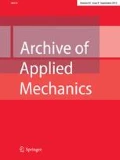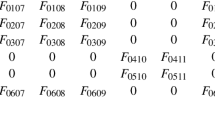Summary
The so-called hypoelastic constitutive equations, defined by the equationℸ=h(T, D), are limited by the requirement thath is linear inD. Dropping this requirement and retaining positive homogeneity of the first degreen inD leads to a broader class of equations which can be calledhypoplastic. Such equations are appropriate to describe the anelastic behaviour of granular materials. Some properties of hypoplastic equations are discussed in this paper including the new notions of yield and bound surfaces which are given a completely different meaning than in classical elastoplasticity. Possiblities to enlarge hypoplasticity towards rate-dependence and more complex intrinsic memory of the material are pointed to.
Übersicht
Die sogenannten hypoelastischen Stoffgleichungen, die durch die Gleichungℸ=h(T, D) definiert sind, werden durch die Forderung, daßh linear inD sein soll, eingeschränkt. Der Ersatz dieser Forderung rung durch die schw]:achere Forderung, daßh positiv homogen 1. Ordnung inD sein soll, führt zu einer breiteren Gruppe von Stoffgleichungen, die alshypoplastisch bezeichnet werden können. Sie sind gut geeignet, das anelastische Verhalten von Granulaten zu beschreiben. Einige ihrer Eigenschaften werden in dieser Arbeit diskutiert einschließlich der Fließ-und Grenzflächen, welchen eine total andere Bedeutung als in der klassischen Plastizitätstheorie zukommt. Möglichkeiten zur Erweiterung der vorgeschlagenen Theorie in Richtung von geschwindigkeitsabhängigen Stoffen und Stoffen mit einem komplexen Gedächtnis werden aufgezeigt.
Similar content being viewed by others
References
Truesdell, C.; Noll, W.: The non-linear field theories of mechanics. In: Flügge, S. (ed.) Encyclopedia of physics, Vol. III/3, pp. 1–602. Berlin, Heidelberg, New York: Springer 1965
Gazetas, G.: Thoughts for a more rationalized greek geotechnical terminology. Proc. Hellenic conf. on geotechnical engineering, Vol. 3, pp. 73–76. Athen: Technical Chamber of Greece 1988
Dafalias, Y. F.: Bounding surface plasticity. I: Mathematical foundation and hypoplasticity. J. Engineering Mech. 112 (1986) 966–987
Chambon, R. P. H.: Une classe des lois de comportement incrémentalement nonlinéaires pour les sols non visquex, résolution de quelques problèmes de cohérence. Comptes Rendus Acad. Sci. Paris, Série II, 308 (1989) (1571–1576)
Gudehus, G.: A comparison of some constitutive laws for soils under radially symmetric loading and unloading. In: Wittke, W. (ed.) Proc. 3rd Int. Conf. num. methods in geomechanics, Aachen, pp. 1309 to 1323. Rotterdam: Balkema 1979
Kolymbas, D.: A novel constitutive law for soils. In: 2nd Int. Conf. on Constitutive Laws for Engineering Methods, Vol. 1, pp. 319–326. Tucson: Elsevier 1987
Koiter, W. T.: General theorems for elastic-plastic solids. In: Sneddon, I.; Hill, R. (eds.) Progress in solid mechanics, vol. 1, pp. 167–221. Amsterdam: North Holland 1960
Kolybas, D.; Rombach, G.: Shear band formation in generalized hypoelasticity. Ing. Arch. 59 (1989) 177–186
Author information
Authors and Affiliations
Rights and permissions
About this article
Cite this article
Kolymbas, D. An outline of hypoplasticity. Arch. Appl. Mech. 61, 143–151 (1991). https://doi.org/10.1007/BF00788048
Received:
Issue Date:
DOI: https://doi.org/10.1007/BF00788048




